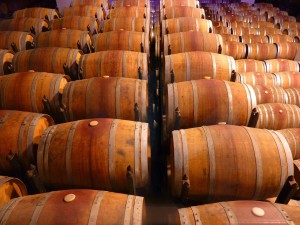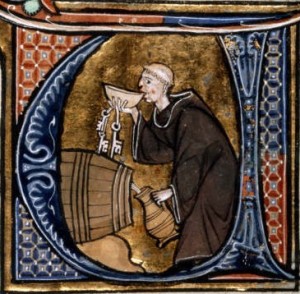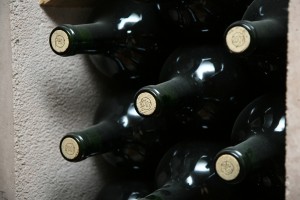Predicting the price of wine futures and determining exactly how much wine to allocate for futures and how much for retail is a very complicated beast. A new study by researchers at Syracuse University in New York and accepted into the journal Manufacturing & Service Operations Management aimed to evaluate wine futures and how they are used as a strategy to mitigate risk associated with unknown bottle quality after production and has come up with a strikingly accurate model for predict wine prices in an uncertain environment. (Read the Press Release here).
What Are Wine Futures?
In very simple terms, wine futures are the selling of wine before it’s even made it into the bottle or on the retail store shelves. The selling of wine futures has been around for quite a long time, though it’s almost exclusively seen in the en primeur system in the Bordeaux wine region of France. Places like Liv-ex.com provide an online auction block, if you will, that allows traders and consumers to purchase wine futures for those wines and wineries participating in the system.
Wine futures exist in the first place to help reduce the risk of winemakers having so much money tied up in the cellar while the wine is aging in barrels (often for about two years). There’s a lot of uncertainty in those two years and no income on that product, so by giving the winery an option to sell futures, they reduce their risk of losing everything in case something happened to that wine that would affect it in a negative way.
Since the French (particularly in Bordeaux) have been doing this for quite some time, they have a pretty solid system down for determining what prices to put on their wine futures as well as how much wine to allocate for futures and how much to allocate for a future retail setting. Factors that influence these decisions are complicated; however some very significant pieces of information include two separate wine scores: the barrel score and the bottle score.
The Barrel Score
For Bordeaux en primeur wines, typically what happens is that after harvest, the wine goes into the barrel. After that wine has been aging in the barrel for about 8 to 10 months, wine critics are brought in to taste the wine and give it a score; the barrel score. For Bordeaux, historically and up until his very recent announcement that he will be stepping down from en primeur futures, Robert Parker, Jr. has been the be-all-end-all wine critic for this stage in the game. For Bordeaux en primeur wines, the barrel score that
Robert Parker Jr. gives typically was what determined whether or not the vintage would be a success or failure in terms of sales and profit margins.
Typically, a wine scored in the upper 90s would be highly desirable for wine retailers as well as collectors, thus significantly driving up the price of the wine futures.
As an aside, the study presented today was written prior to the knowledge of Robert Parker Jr.’s departure from tasting Bordeaux en primeur wine futures, so it’ll be interesting to see how this model will hold up in the future. (Read about Robert Parker Jr’s departure from tasting en primeur wines from The Wall Street Journal here).
The Bottle Score
The bottle score is pretty self-explanatory: it is the score that the wine critics or journalists give the wine after it has been in bottle. Of course, this doesn’t occur until well after the wine futures price is set and wine has been allocated for either wine futures or the retail setting, however, it is still an important factor to consider, particularly if the wine improved significantly from the barrel score to the bottle score.
Risks & Benefits of Wine Futures for the Winery
One obvious benefit to wine futures for the winery is that they end up making money immediately instead of having to wait two years and hope for profit at that time. However, what happens in the situation when the quality of the wine actually improved significantly from the barrel tasting to the bottle tasting?
At this point, assuming the barrel score was relatively low compared to the bottle score, a certain amount of money could have been made on the wine futures. However, in the long run the winery ends up losing money, because with a higher bottle score, they could have charged significantly more money in the retail setting and therefore lost out on possible big profits by having the wine future system in place.
In another scenario, let’s say after the barrel score the winery allocated a certain amount of wine for futures, and certain amount of wine for the retail setting. What happens if the quality of the wine declined from the barrel tasting to the bottle tasting?
In this situation, the winery ends up losing money again because while the wine may have tasted good during the barrel tasting and a subsequent relatively high price point set, the wine went downhill for some reason and now that it’s two years later and on the shelf, the consumers aren’t going to pay that much for
something that’s worse than it was two years ago. This situation now becomes one where the winery set aside too much wine for the retail setting and not enough for wine futures.
So, as you can see, knowing how much to allocate toward wine futures and how much to set aside for the retail setting is a difficult task to complete. There’s no simple way around it, and yes, sometimes the winery makes a bad decision and money is lost.
Consumer Preferences and Risk Uncertainty
If pricing wine futures were just up to the winery and a critic, then the model would be very simple. However, one major player in the risk calculation is the consumer themselves. Who are the consumers? What is the market like? How does the economy influence consumer buying decisions? A lot of these sorts of things go into the model and significantly influence how much a winery can charge for their wine futures.
Consumer Homogeneity versus Heterogeneity
Depending upon the region, you might see a group of consumers as behaving in a similar fashion (homogenous), or you might see a group of consumers with markedly different buying behavior from person to person (heterogeneous).
In the case of a homogenous group of consumers, as we see for small craft wineries in the United States, one has to assume they all have the same willingness to pay for wine futures. Knowing your consumer base would be key to setting that price. Set the price too high, none of your potential customers will buy your wine futures. Set the price too low, the consumers will buy the futures but you’ll lose out on the difference between what they actually paid and what they would have been willing to pay.
In the case of a heterogeneous group of consumers, as we see in Bordeaux en primeur, you’ll find some that are willing to pay a lot for wine futures, while others are not willing to pay very much at all. In this situation and what has been seen to be successful in places like Bordeaux en primeur, the price of the futures are set very high. As long as it’s not TOO high, there will always be a subset of consumers willing to pay the price. Then later on, the winery can reel in the other consumers who were not willing to pay so much for futures by having them spend a premium amount on the bottle of wine in the retail store. Achieving the right balance between these two price values as well as how much wine to set aside for futures and how much to set aside for retail is key in maximizing profits in the wine futures game.
Enter the new study by researchers from Syracuse University…
Using complicated mathematical modeling, the researchers from Syracuse created a model that predicts with high accuracy the pricing of wine futures and validated that model using data from Liv-ex on past Bordeaux en primeur wine future prices (for the 2006 through 2011 vintages). Finally, the study took this model one step further to determine if wine futures are an appropriate practice for small boutique wineries that we see often in the United States by using a winery in New York as an example.Note: There is a link to this study which is available for you to download for free at the end of this post.
Model Findings:
Results from the model developed by the researchers at Syracuse University showed:
BORDEAUX EN PRIMEUR
- Barrel score was significantly and positively correlated with wine allocation as well as wine futures price. The higher the barrel score, the more wine set aside for futures and the higher the price.
- Predicted prices based on the Syracuse model and actual prices based on data from Liv-ex showed a 96% correlation, indicating that the Syracuse model was incredibly accurate in predicting wine future prices based on empirical data and model parameters.
- The presence of a wine futures system increased Bordeaux en primeur winery profits by an average of 10.10% (range 5.71% to 22.70%). Having a wine futures system is significantly beneficial to Bordeaux en primeur wineries from a financial stand point.
- One of the lowest barrel score improved profits by 1.17%.
- One of the highest barrel score improved profits by 41.81%.
- When barrel scores were low, less wine was set aside for futures and more wine allocated to retail.
- Based on all the data, wineries should have set aside 27.65% of their wines on average to wine futures (range 12.30% to 64.03%).
US CRAFT/ARTISANAL/BOUTIQUE WINERIES
NOTE: The small US winery used for this analysis was Heart & Hands Wine Co. in the Finger Lakes region of NY.
ALSO NOTE: Robert Parker Jr. isn’t exactly scoring the wines from small craft wineries like Heart & Hands Wine Co. or hardly any other for that matter, so barrel and bottle scores were obtained from Wine Spectator for this analysis.
Using the same model that predicted wine futures prices in Bordeaux with significant accuracy, the researchers found:
- The existence of a wine futures system for small wineries in the United States would increase Heart & Hands Wine Co.’s profits by an average of 13.87% (range 12.97% to 15.59%).
- Despite having much lower barrel scores than Bordeaux en primeur wines, the model predicted that Heart & Hands Wine Co. should set aside 55.05% of their wines for wine futures (significantly more than Bordeaux en primeur’s 27.65%).
CONSUMER BEHAVIOR
- Bordeaux en primeur consumer base is generally heterogeneous, while the US small winery consumer base is generally homogenous.
- Bordeaux en primeur wineries saw higher profits from higher wine future prices and increased heterogeneity in their consumer base.
- If the consumer base for Heart & Hands Wine Co. in New York were heterogeneous, the model showed that profits would actually decrease if they increased wine future prices as they do in Bordeaux. The key difference here is likely related to reputation. Bordeaux en primeur wineries are much more well-known than little boutique wineries in the United States, so the French have more flexibility in raising wine future prices. If one day the reputation of Hearts & Hands Wine Co. matched that of the Bordeaux en primeur wineries, then the model would suggest that they, too, could raise their wine future prices in an increasingly heterogeneous consumer base.
Conclusions
This new study by Syracuse University researchers presents a new model for predicting wine future prices as well as how much wine to allocate to wine futures and to retail based on historical data from the Bordeaux en primeur market system. They were able to predict with extreme accuracy wine futures prices (correlations of 96% between predicted and actual prices), potentially allowing wineries to be able to apply the model to their own wines and consumer base in order to more accurately determine 1) how much wine should they set aside for wine futures and how much to retail; 2) what price to set for wine futures; and 3) if getting into a wine futures system would be financially beneficial for them or not.
It was interesting to see that according to this new model, a wine futures system in the United States, specifically with small craft/artisanal/boutique wineries may be beneficial and may ultimately increase profits and economic stability in a not-so-stable environment.
Before this model can be implemented on a larger scale however, more research needs to be done. First,
![Photo By Peter from Wellesley (Port Barrels) [CC BY 2.0 (http://creativecommons.org/licenses/by/2.0)], via Wikimedia Commons](http://www.academicwino.com/wp-content/uploads/2015/04/wine-barrel-aging-the-academic-wino-300x200.jpg)
Photo By Peter from Wellesley (Port Barrels) [CC BY 2.0 (http://creativecommons.org/licenses/by/2.0)], via Wikimedia Commons
Another problem is that we don’t actually have a wine futures system current in place in the United States. While the model suggests profits could improve and a wine futures system could be financially beneficial for small wineries, no such system actually exists in the US. A wine futures system would need to be developed, which while it doesn’t happen overnight, could potentially develop over time.
Global economics and consumer behavior will likely change in the future, as it always does, so continuing to collect data over time for both Bordeaux en primeur, small wineries in the United States, and wine industries all over the globe will be key in helping to develop a more stable cash flow for wineries in this seemingly unstable environment.
WANT TO KNOW MORE?
Download the paper for free by clicking on the citation below:
Or watch this video summary by one of the researchers:




![Photo By ZeWrestler (Own work) [Public domain], via Wikimedia Commons](http://www.academicwino.com/wp-content/uploads/2015/04/Lyman_Hall_Syracuse_University-the-academic-wino-300x225.jpg)
1 comment for “A New Model Predicts Wine Futures Prices With High Accuracy: Lessons from Bordeaux En Primeur for Small Boutique Wineries in the US”